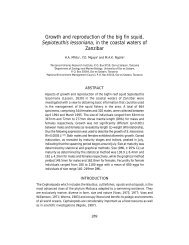gpa_east_africa_case.. - GRID Africa GeoPortal - UNEP
gpa_east_africa_case.. - GRID Africa GeoPortal - UNEP
gpa_east_africa_case.. - GRID Africa GeoPortal - UNEP
Create successful ePaper yourself
Turn your PDF publications into a flip-book with our unique Google optimized e-Paper software.
occasionally used as last resort water sources by poor families in unplanned settlements whocannot afford to purchase water commercially.Industry. 80% of the nations’ industries are located in the DSM region. In 1999 there were412 industries on the register of the Ministry of Industries and Trade, including some whichmay have since ceased to operate.Industries in Dar es SalaamCategoryNo. of industriesFood and beverage manufacturing, chemicals and cosmetics 162Metal products 55Textile mills, garments, leather and plastic products 90Paper & paper products, Printing, Publishing & allied industries 33Wood and wood products 17Building & construction materials 14Electrical appliances, battery industries 12Animal feed 8Motor / vehicles assembly and maintenance 10Glass & Glass products 5Ginnery and tobacco 3Mineral 2Petroleum refineries 1Source: Ministry of Industries and Trade. (International Standards: Industrialclassification of all economic activities Part II List of major Divisions, Divisions andmajor groups).Tourism. The coastal climate is favourable to beach tourism. In DSM there are more than 13tourist hotels, and new ones are under construction, with a total of 5,000 beds. The main onesinclude the Sheraton Hotel, New <strong>Africa</strong> Hotel, Kilimanjaro Hotel (now inoperative),Silversands Hotel, Whitesands Hotel, Jangwani Beach Hotel, Haven of Peace Hotel, Sea CliffHotel, <strong>Africa</strong>na Hotel, Kunduchi Beach Hotel, Bahari Beach Hotel, Oysterbay Hotel, KaribuHotel. According to the Ministry of Natural Resources & Tourism and the Tanzania TouristBoard, the annual average number of tourist is about 201,000 with average annualexpenditure of US$ 190 million.Commercial and Industrial activity and the "Informal Sector". Until the 1980s, the maincommercial and industrial areas were mainly those designated by the Urban Master Plan ofthe City, covering an area of some 170 ha for the Central Business District and over 2000 hafor the and industrial areas. By 1992, industrial sites sprawled and doubled in size; smallscalecommercial, industrial and service units mushroomed throughout the city, in response tohigh urbanisation and rising unemployment in the formal sector, occupying city centerpavements, road junctions, transportation terminal sites, as well as locations along arterialroad reserves. The informal sector in DSM region is growing rapidly. In 1991, the Ministry ofLabour and Youth Development counted more than 210,000 businesses with an average of1.5 jobs per enterprise (Report on Self-help organisation in the informal sector of the DSM,SIDO/GTZ Project, 1995). By definition many informal activities are low-cost, unregisteredand escape official statistics; 95% of informal businesses are survival activities. Overall, theinformal sector is estimated to generate over 32% of the officially recorded Gross DomesticProduct. Earnings per worker are 2.6 times higher the minimum wages in the urban formalsector..Agriculture. Of the total area of DSM of 1,350km2, an area of 430km2 (or 32%) is taken upby urban development, 20km2 is forest land and 900km2 (or 67%) is rural only part of it inagricultural use. Agriculture is however the main activity within the region. Satellite imagepictures suggest that as much as 23% of the area of the region is used for agricultureproduction.Fishing. The total population of fishermen is disputed, estimates range from 3,000 - 50,000.This vast difference is explained by the small number of licensed fishermen relative to themuch larger number of non- registered fishermen. Despite the number of rivers crossing thecity and the few fresh water lakes and ponds, inland fisheries are limited. Offshore fisheriesFinal Draft Report – Cost Benefit Case StudiesGPA Strategic Action Plan on Sewage, October, 200079



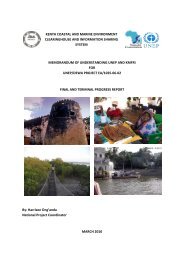

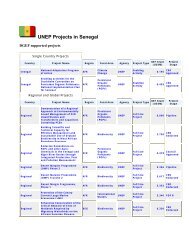

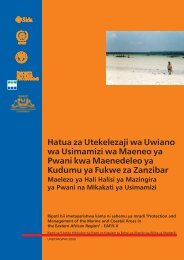
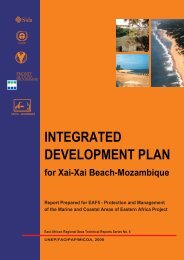
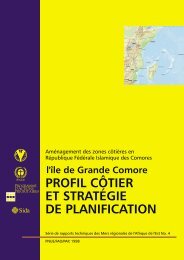
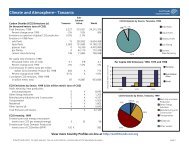

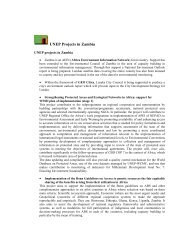
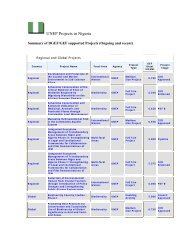
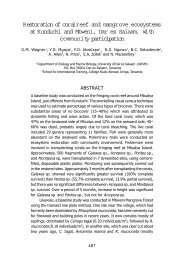
![Please Click to download [English] - GRID Africa GeoPortal - UNEP](https://img.yumpu.com/30633391/1/184x260/please-click-to-download-english-grid-africa-geoportal-unep.jpg?quality=85)
